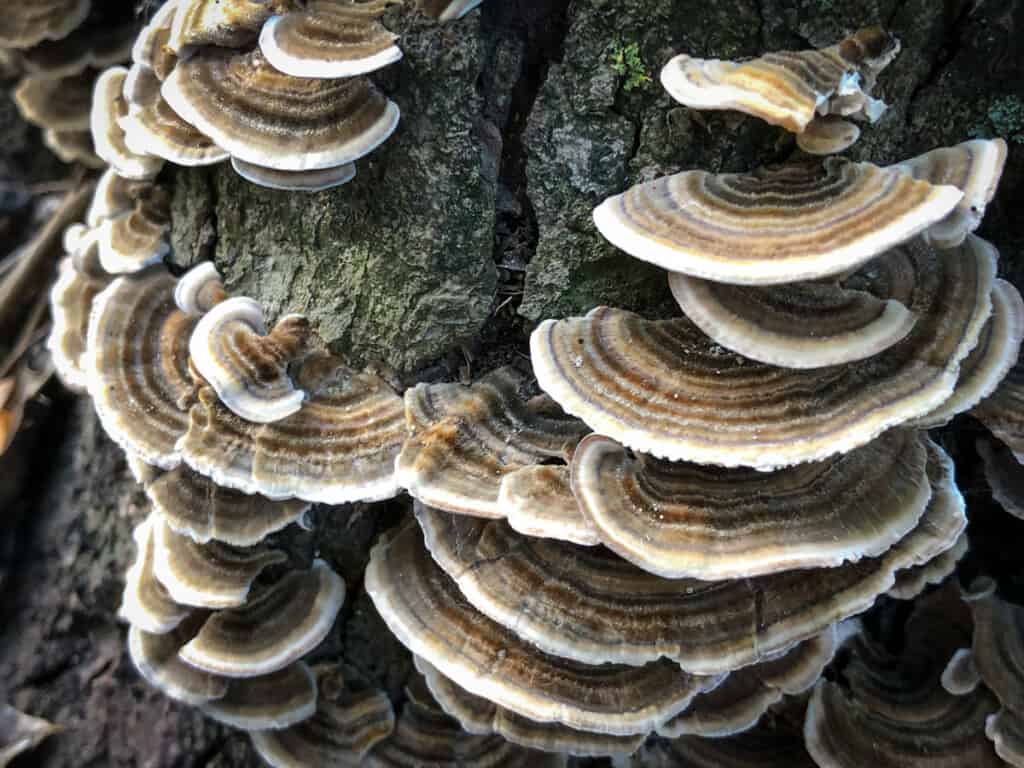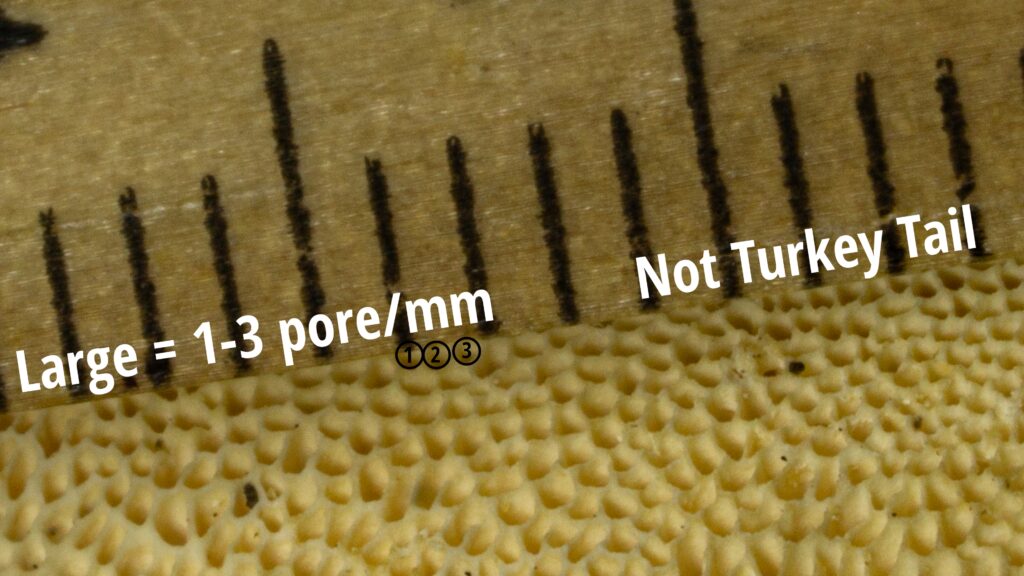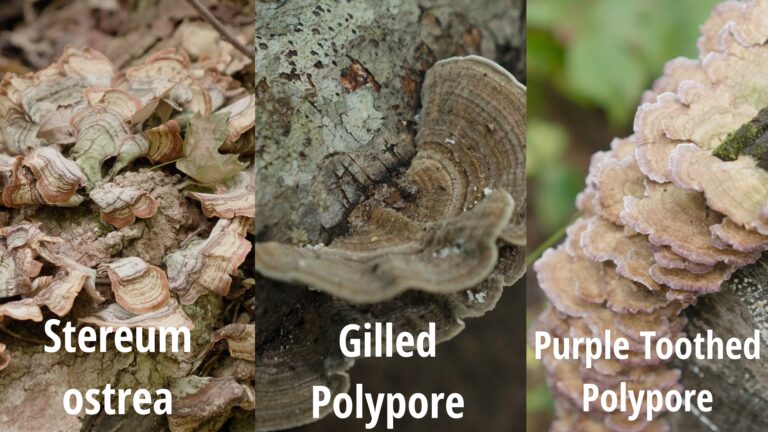Turkey Tail has quickly become one of the most popular consumer mushrooms on the market! While we could go to the store to purchase it ourselves we would be depriving ourselves of the opportunity to spend time in nature foraging for it (and saving money!) There are many lookalikes to Turkey Tail and before using it (or any foraged good), it is imperative that you understand Turkey Tail identification to confidently get a 100% positive ID!
Luckily for us Turkey Tail identification is not a difficult task if you know what to look for. This article highlights those details and how they distinguish Turkey Tail from its lookalikes.
Turkey tail mushrooms are one of the most common wild mushrooms found growing in forests around the world. Their distinct fan shape and colorful stripes make them easy to spot on decaying logs and stumps. But there are also several lookalike species, so it’s important to know the key identifying features of true turkey tails.
In this article we’ll go through everything you need to confidently identify these mushrooms, including detailed photos and descriptions of their key characteristics. We’ll also compare turkey tails to common imposters so you can learn to tell the difference.
An Overview of Turkey Tail Characteristics
Turkey tail mushrooms, scientifically known as Trametes versicolor, get their common name from their resemblance to the fanned tail feathers of a turkey. The caps are thin and flexible with a velvety texture on the surface. They grow in shelflike clusters, often stacked on top of each other.
The topside displays colorful concentric bands in shades of brown, red, gray, orange, blue, green, and white. The underside has tiny pores instead of gills. When fresh, turkey tails are soft but turn brittle when dried.
Detailed Look at Turkey Tail Features
Let’s go through the key characteristics in more detail so you know what to look for when identifying turkey tails:
1. Multiple Thin, Flexible Fan-Shaped Caps
Turkey tails grow in tiered, overlapping clusters with each mushroom having a thin, fan-shaped cap. The caps are flexible when fresh, but become brittle when dried.
They can grow alone but more commonly form shelf-like layers, with younger mushrooms stacked on top of older ones The caps may merge together at the base
2. Concentric Colorful Bands on Topside
The upper surface displays colorful stripes in shades of brown black, gray blue, orange, red, yellow, and white. The bands follow the contours of the fan-shaped caps.
The number of stripes can vary from just a few to dozens. The coloring helps camouflage the mushrooms on forest debris.
3. Tiny Velvety Hairs on Cap Surface
When viewed up close, the surface of the caps have a soft velvety texture composed of tiny little hairs. This velvetiness distinguishes turkey tails from lookalikes.
4. White Underside with Small Pores
The underside of turkey tail caps are white and covered in tiny pores. These pores produce spores for reproduction.
Pores are a key feature that helps differentiate true turkey tails from lookalikes which often have smooth undersides.
5. Growing on Dead Wood
In the wild, turkey tail mushrooms grow on dead trees, logs, branches, and stumps, helping decompose the decaying wood. They are saprotrophic, meaning they obtain nutrients by breaking down organic matter.
You’ll rarely find them growing on live trees. The presence of algae on the caps can indicate the log has been dead for a long time.
Differences from Lookalikes
There are a few other species that resemble turkey tails. While none are poisonous, they won’t provide the nutritional benefits. Here are tips for telling lookalikes apart:
False Turkey Tail
False turkey tail (Stereum ostrea) is the most common imposter. It lacks pores on the underside, instead having a smooth yellow surface. It also lacks velvety hairs on top.
Violet Toothed Polypore
The violet toothed polypore (Trichaptum biforme) has a smooth underside with tooth-like folds instead of pores. Its cap margins are usually tinged violet.
Maze Polypore
The maze polypore (Daedaleopsis confragosa) has true pores on the underside. But its caps have a maze-like pattern of ridges rather than concentric rings.
Benefits of Properly Identifying Turkey Tails
Correctly identifying turkey tails is important because they contain polysaccharides and other compounds linked to health benefits. Consuming true turkey tail tea or supplements may help boost immunity, fight inflammation, and support gut health.
Imposters lack these beneficial compounds, so proper ID is key. It also ensures you don’t inadvertently consume unknown species.
Following the steps outlined here will equip you to confidently identify true turkey tails in the wild. Then you can forage and use them for teas, tinctures, and DIY remedies. With a little practice, telling turkey tails apart from lookalikes will be easy.
So grab your mushroom field guide and start searching for these vibrant fungi on your next forest walk! Correct identification is the first step in utilizing turkey tails for their health benefits.

What do “tiny” pores look like?
Step 2 of the test states, to look for “tiny” pores. Technically speaking, this means that per 1 mm there would be about 3-8 pores across. In order to better see that I took a photo with my macro lens to actually show turkey tail pores against a ruler.
There are two photos, taken at the same distance. The first is of Turkey Tail pores showing how with the specimen captured it has about 6 pores/mm. The second is of a false turkey tail which has large pores, there are only 3/mm.



- “False Turkey Tail” – Stereum ostrea group
- Violet Toothed Polypore – Trichaptum biforme
- Gilled Polypore – Trametes betula
The above list contains, in my opinion, the most common lookalikes to Turkey Tail that you are likely to encounter when scouting for it out in the woods! There are of course many more, but this will get you started on seeing a few major differences between Turkey Tail. If you are using the test, these will all be eliminated fairly quickly!
A Video Identification Guide
MushroomExpert is a wonderful written resource, but if you are looking for a full video guide. You can check out the YouTube video linked below from the Feral Foraging YouTube channel!
There are a few items from the Totally True Turkey Tail Test that I think benefit greatly from a visual reference. They are outlined below!
How to Identify Turkey Tail Mushrooms ( and distinguish from false lookalikes )
FAQ
How do you identify a turkey tail?
What are the false turkey tail look alike?
What part of the turkey is turkey tails?
What does a false turkey tail look like?
The False Turkey tail is not a polypore like the True Turkey tail so it does not have pores on the underside. It is a shelf like bracket looking mushroom similar to the True Turkey tail. This one is a crust fungus. When you fist see this mushroom you may think it looks like a paint stain on the mood when it is actually a mushroom.
How do you know if a turkey tail mushroom is real?
Here are some tips to help identify turkey tail mushrooms: Check the Pores: Turkey tail mushrooms have tiny pores on the underside of the cap, which are white or light-colored. The pores should be very small and tightly grouped together. If the pores are larger, it could be a false turkey tail mushroom.
What is the difference between a turkey tail and a mushroom?
The difference is in the coloration. While turkey tails have striped colored rings, these fungi are grey or white. A closer look also reveals they are fuzzier (have longer “hair” than the turkey tail). While this mushroom is very colorful and beautiful on the top, when you flip the mushroom on it’s underside it should be white when its fresh.
How do you know if a turkey tail is real?
Real turkey tail has a flexible and thin body. Unlike many other crust or bracket fungi, you can bend it easily. It usually has subtle ridges along its body and edges where it fans out, so the surface can feel bumpy. However, it will also feel soft to the touch. The cap is covered with fine hairs that give it a nice, velvety finish.
